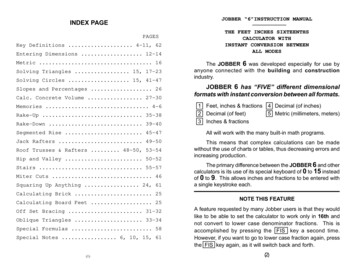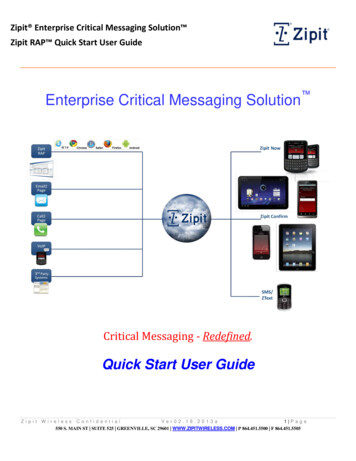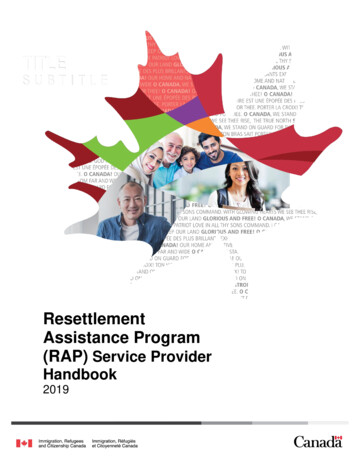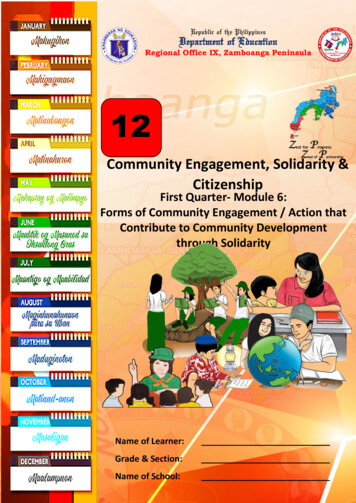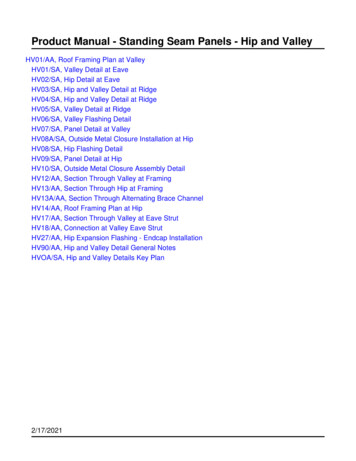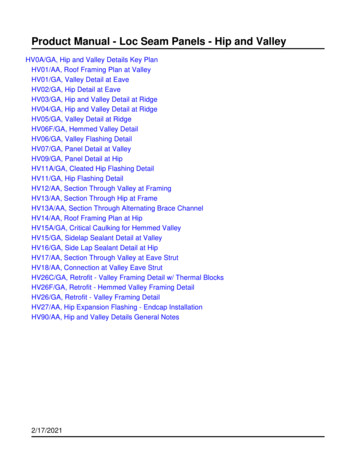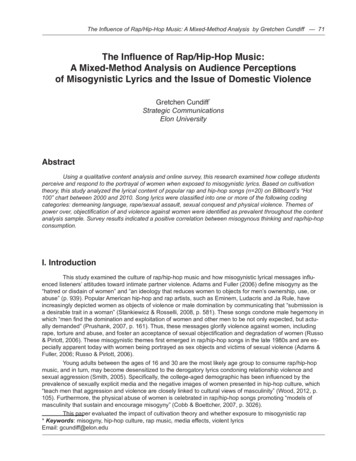
Transcription
The Influence of Rap/Hip-Hop Music: A Mixed-Method Analysis by Gretchen Cundiff — 71The Influence of Rap/Hip-Hop Music:A Mixed-Method Analysis on Audience Perceptionsof Misogynistic Lyrics and the Issue of Domestic ViolenceGretchen Cundiff*Strategic CommunicationsElon UniversityAbstractUsing a qualitative content analysis and online survey, this research examined how college studentsperceive and respond to the portrayal of women when exposed to misogynistic lyrics. Based on cultivationtheory, this study analyzed the lyrical content of popular rap and hip-hop songs (n 20) on Billboard’s “Hot100” chart between 2000 and 2010. Song lyrics were classified into one or more of the following codingcategories: demeaning language, rape/sexual assault, sexual conquest and physical violence. Themes ofpower over, objectification of and violence against women were identified as prevalent throughout the contentanalysis sample. Survey results indicated a positive correlation between misogynous thinking and rap/hip-hopconsumption.I. IntroductionThis study examined the culture of rap/hip-hop music and how misogynistic lyrical messages influenced listeners’ attitudes toward intimate partner violence. Adams and Fuller (2006) define misogyny as the“hatred or disdain of women” and “an ideology that reduces women to objects for men’s ownership, use, orabuse” (p. 939). Popular American hip-hop and rap artists, such as Eminem, Ludacris and Ja Rule, haveincreasingly depicted women as objects of violence or male domination by communicating that “submission isa desirable trait in a woman” (Stankiewicz & Rosselli, 2008, p. 581). These songs condone male hegemony inwhich “men find the domination and exploitation of women and other men to be not only expected, but actually demanded” (Prushank, 2007, p. 161). Thus, these messages glorify violence against women, includingrape, torture and abuse, and foster an acceptance of sexual objectification and degradation of women (Russo& Pirlott, 2006). These misogynistic themes first emerged in rap/hip-hop songs in the late 1980s and are especially apparent today with women being portrayed as sex objects and victims of sexual violence (Adams &Fuller, 2006; Russo & Pirlott, 2006).Young adults between the ages of 16 and 30 are the most likely age group to consume rap/hip-hopmusic, and in turn, may become desensitized to the derogatory lyrics condoning relationship violence andsexual aggression (Smith, 2005). Specifically, the college-aged demographic has been influenced by theprevalence of sexually explicit media and the negative images of women presented in hip-hop culture, which“teach men that aggression and violence are closely linked to cultural views of masculinity” (Wood, 2012, p.105). Furthermore, the physical abuse of women is celebrated in rap/hip-hop songs promoting “models ofmasculinity that sustain and encourage misogyny” (Cobb & Boettcher, 2007, p. 3026).This paper evaluated the impact of cultivation theory and whether exposure to misogynistic rap* Keywords: misogyny, hip-hop culture, rap music, media effects, violent lyricsEmail: gcundiff@elon.edu
72 — The Elon Journal of Undergraduate Research in Communications Vol. 4, No. 1 Spring 2013increases the acceptance of perpetrating violent acts against women (Johnson, Jackson, & Gatto, 1995).Also, this paper incorporated the disinhibition hypothesis in relation to how audiences become desensitized tomedia violence after repeated exposure (Rosenberry & Vicker, 2009). Analyzing the relationship between rap/hip-hop lyrical content and song popularity showed how audiences have responded to objectifying messagesthrough their music consumption.II. Literature ReviewIssue of Domestic ViolenceDomestic violence is a pressing issue often deemed acceptable by the media, and thus, challengesmen and women’s perceptions of how they should treat their partners in their relationships. Over the past twodecades, the United Nations Commission on the Status of Women “reported a tremendous increase in therepresentation of violence against women, particularly sexual violence, in the media” (Stankiewicz & Rosselli,2008, p. 581). Studies suggest that increased exposure to misogynistic messages has desensitized audiences to the issue of intimate partner violence and fosters greater tolerance of male aggression (Barongan& Hall, 1996). The mass media portrays domestic violence both visually and aurally by normalizing the useof force in relationships, which correlates to the fact that “more than one in three women in the United Stateshave been sexually coerced by a partner” (Nettleton, 2011, p. 140). Therefore, it is not surprising that “mencommit at least 90% of documented acts of physical intimate partner violence in the U.S.” by exerting controlover women (Wood, 2012, p. 301).The ambiguity of what constitutes sexual assault or intimate partner violence contributes to publicmisperception of domestic violence. The Office of Violence Against Women defines domestic violence as a“pattern of abusive behavior in any relationship that is used by one partner to gain or maintain power andcontrol over another intimate partner” (“What Is Domestic Violence?,” 2012). Physical, sexual and psychological actions or threats of abuse toward a partner are the most common forms of domestic violence (“WhatIs Domestic Violence?,” 2012). Domestic violence includes behaviors that “intimidate, manipulate, humiliate, isolate, frighten, terrorize, coerce, threaten, blame, hurt, injure, or wound someone” (“What Is DomesticViolence?” 2012). The National Violence Against Women Survey, conducted by Tjaden and Thoennes (2000),estimates that one in five women in the United States is physically assaulted in her lifetime and one in 13 israped by an intimate partner (Russo & Pirlott, 2006).While women of all ages are at risk of experiencing domestic and sexual violence, those between theages of 20-24 are most susceptible to experiencing nonfatal intimate partner violence (“Get the Facts: TheFacts,” 2007). According to a 2007 study by Laurel Crown and Linda Roberts, “one-half of college womenin their senior year reported one or more unwanted sexual interactions during their college careers” (Wood,2012, p. 287). The perpetration of violent behavior can be explained using the cognitive learning theory,asserting, “individuals receive messages through society and media that shape relationship ideologies”(Bretthauer, Zimmerman, & Banning, 2006, p. 30). This study specifically analyzed college students’ views onthe issue of domestic violence and its portrayal in popular rap/hip-hop music.Misogyny in Rap/Hip-Hop MusicIn a recent content analysis of six types of media, Pardun, L’Engle, and Brown (2005) found thatmusic, in particular, contained substantially more sexual content than any other media outlets. Sexuallyexplicit and derogatory lyrics are especially apparent in rap music, which has been criticized for its graphicderogatory presentation of women using lyrics that objectify, exploit or victimize them (Weitzer & Kubrin, 2009;Cobb & Boettcher, 2007). Adams and Fuller (2006) assert that rap music reduces women to objects “that areonly good for sex and abuse,” which “perpetuate ideas, values, beliefs, and stereotypes that debase women”(p. 940). This study also noted six themes common in misogynistic rap music, and further examined threeof them: derogatory statements about women in relation to sex; statements involving violent actions towardwomen, particularly in relation to sex; and references of women as usable and discardable beings (Adams &Fuller, 2006).Armstrong (2001) conducted a content analysis of 490 rap songs from 1987 to 1993, in which 22%
The Influence of Rap/Hip-Hop Music: A Mixed-Method Analysis by Gretchen Cundiff — 73contained lyrics featuring violence against women including assault, rape and murder. His study classifiedrap songs into different categories in which rappers either pride themselves on sex acts appearing to harmwomen, justify other acts of violence, warn women who challenge male domination that they will be assaulted,and/or seem to invite male violence against women (Armstrong, 2001). Weitzer and Kubrin (2009) conducteda follow-up study analyzing the portrayal of women in 403 rap songs through a content analysis, in whichthemes of derogatory naming and shaming of women; sexual objectification of women; distrust of women;legitimation of violence against women; and celebration of prostitution and pimping appeared at the greatestfrequency. Sexual objectification was found to occur in 67% of the misogynistic lyrics in their songs sampled(Weitzer & Kubrin, 2009). This study further examined the frequency of explicit music content found in thepast decade’s worth of popular rap/hip-hop music. Furthermore, stereotyped gender roles emerged from lyricscontaining sexual imagery that promote the “acceptance of women as sexual objects and men as pursuers ofsexual conquest,” (Martino, Collins, Elliott, Strachman, Kanouse, & Berry, 2006, p. 438).Influence on Audience PerceptionsGeorge Gerbner focused on violent television content and how audience exposure to these violentimages influences their views and conception of social reality, by cultivating a “common view of the world”(Rosenberry & Vicker, 2009, pg. 165). As a result, Gerbner developed cultivation theory by examining howlong-term exposure to violent media messages alters audience perceptions of violence in their everyday lives(Rosenberry & Vicker, 2009). This approach can be applied to all forms of media by interpreting individuals’reactions to violent content; thus, this study will incorporate cultivation theory in an analysis of misogynisticlyrics affecting listeners’ attitudes toward domestic violence (Rosenberry & Vicker, 2009).In reviewing more than five decades worth of research, Potter (1999) extended cultivation theory todetermine the following effects of exposure to media violence:Exposure to violent portrayals in the media can lead to subsequent viewer aggressionthrough disinhibition. Long-term exposure to media violence is related to aggression in a person’s life. Media violence is related to subsequent violence in society. Exposure to violence inthe media can lead to desensitization. People exposed to many violent portrayals over timewill come to be more accepting of violence. (Rosenberry & Vicker, 2009, p. 169)In turn, Dr. Edgar Tyson (2006) developed a 26-item instrument, the Rap Music Attitude and Perception (RAP) Scale, the “only tool available to access an individual’s attitude toward and perception of rapmusic lyrics” (p. 212). The RAP Scale contains three constructs: empowerment, artistic aesthetics and violentmisogynistic. This study incorporated the empowerment and violent misogynistic constructs to measure “violent, sexist, and misogynistic images conveyed in the lyrics” to examine college students’ perceptions of thecontent through a survey (Gourdine & Lemmons, 2011, p. 65). Using a meta-analysis approach, Timmermanet. al (2008) found that “listening to music generates an effect on listeners consistent with the content of themusic,” such as when rap/hip-hop artists communicate themes condoning “power over, objectification of andviolence against women” (p. 303; Bretthauer et al., 2006, p. 42). This 2008 study applied the term “priming” todetermine “whether music serves as a mechanism to ‘prime’ someone for subsequent actions and behaviors,”and in turn, react to, incorporate or reject the media content into the listener’s life (Timmerman et. al., 2008, p.307). While a correlation may exist between exposure to misogynistic music and audience attitudes regarding violent acts against women, a causal link cannot be demonstrated between listening habits and resultingmisogynistic behavior (Baran & Davis, 2006, p. 331). Therefore, the consumption of misogynistic music caninfluence audience perceptions of misogynistic content, but does not directly lead to “subsequent aggressiveactions” (Timmerman et. al., 2008, p. 307).This study expanded upon previous research incorporating the RAP Scale, priming and cultivationtheory to determine how college students’ perspectives on issues of domestic violence reflect misogynisticthemes emphasized in explicit rap/hip-hop music.Research QuestionsThis study explored whether consuming rap/hip-hop music containing misogynistic messages affectsthe attitudes of audiences regarding domestic violence.RQ. 1: How do college students perceive and respond to the portrayal of women when exposed tomisogynistic lyrics?
74 — The Elon Journal of Undergraduate Research in Communications Vol. 4, No. 1 Spring 2013RQ. 2: Does gender impact how college students interpret misogynistic messages found within popular rap/hip-hop songs?III. MethodThis study used cultivation theory to examine the media effects of misogynistic rap and hip-hop musicon shaping audience attitudes toward intimate partner violence. By incorporating a qualitative content analysis and an online survey, this study analyzed the lyrical content of popular rap and hip-hop songs found onBillboard’s “Hot 100” chart over the past decade. The sample of 20 songs was drawn from Billboard’s YearEnd “Hot 100” singles list, which includes the most popular music from various music genres. These werechosen due to the specific violent or objectifying terminology found within the lyrics of top-ranked rap andhip-hop songs during this study’s qualitative content analysis. The Billboard “Hot 100,” issued weekly by Billboard magazine, is the music industry’s standard for measuring song popularity in the United States based onradio airplay, online streaming activity, physical CD sales and digital downloads (“Billboard Hot 100”). NielsenSoundscan compiles the “Hot 100” chart rankings based on weekly audience impressions starting the firstweek in December each year (“Billboard Hot 100”). Year-end chart totals are calculated in the final week ofNovember to determine the top 100 songs per year for all music genres combined (“Billboard Hot 100”).Cultivation TheoryThe meanings underlying the songs’ lyrical messages were analyzed through the lens of cultivationtheory, which proposes “when people are exposed to media content or other socialization agents, they gradually come to cultivate or adopt beliefs about the world that coincide with the images they have been viewingor messages they have been hearing” (Gerbner, Gross, Morgan, & Signorielli, 1994, p. 22). Cultivation theoryfurther asserts that the more audiences are exposed to factors such as sexual aggression, submission orviolence in intimate relationships, the more they accept the objectification of women over time (Gerbner, et.al, 1994). This study specifically examined gendered audiences’ interpretation of misogynistic messages inpopular rap/hip-hop songs to see if there were group differences in the effects of media content (Martino, et.al, 2006).Qualitative Content AnalysisContent analysis is described as “a research technique for objective, systematic and quantitativedescription of the manifest content of communication” to investigate messages and reduce them into categories (Rosenberry & Vicker, 2009, pg. 42). According to Zhang & Wildemuth (2009), qualitative content analysis“pays attention to unique themes that illustrate the range of meanings of the phenomenon rather than the statistical significance of the occurrence of particular text or concepts” (p. 309). Using a qualitative content analysis guided by cultivation theory, this study examined the presence or absence of violent misogynistic lyricsfound in 20 popular rap and hip-hop songs between 2000 and 2010. The song lyrics were obtained from various Internet sources (e.g., azlyrics.com) and coded line by line. Songs were classified into one or more of thefollowing coding categories based on images and messages conveyed in lyrics: demeaning language, rape/sexual assault, sexual conquest and/or physical violence. Songs were also labeled according to their level ofmisogynistic content, based on the number of categories into which the lyrics were coded: high, medium orlow levels of misogyny. The coding categories--derogatory naming and shaming of women; sexual objectification of women; and legitimation of violence against women--were adopted from Weitzer and Kubrin’s (2009)content analysis study and incorporated into this present study.Description of coding categories Songs referencing acts of physical violence toward women were coded as such if they containedwords including: slap, punch, push, beat, hit, bleeding, pain, throw, pin, tie, whippings, murder, etc. Songs insinuating rape or sexual assault were coded as such if they contained words/phrases including: fuck, rape, assault, cut up, bust open, etc.
The Influence of Rap/Hip-Hop Music: A Mixed-Method Analysis by Gretchen Cundiff — 75 Songs labeling women in derogatory ways were coded as such for using demeaning language containing the following words: pussy, bitch, pimp, nigga, etc. Songs portraying sexual conquest were coded as such if they contained phrases including: love em/leave em, feel the pain, don’t have to fight back, etc.Frequency/emphasis of misogynistic lyrics Songs were first coded for their misogynistic terminology and then evaluated for their amount ofmisogynistic content and labeled accordingly.* One to two misogynistic lyrical references low level of misogyny* Three to four misogynistic lyrical references medium level of misogyny* Five or more misogynistic lyrical references high level of misogynySurveyIn conjunction with performing a content analysis, this study administered a survey using Survey Monkey to gauge college students’ perceptions of the portrayal of intimate partner violence in the songs examinedbelow. Surveys involve a correlational method by which researchers measure two or more variables andexamine relationships between them (Rosenberry & Vicker, 2009). This 12-question survey was disseminatedto a convenience, nonprobability sample of 62 Elon University students, 52 women and 10 men, representingsophomores through seniors. These students were asked via email or social media to click a link to a SurveyMonkey questionnaire page. The first six questions asked respondents general questions about their viewson rap/hip-hop music and interpretation of musical content. This involved a series of multiple-choice questionsevaluating audience listening behavior; the emphasis on lyrics versus melody in this genre; the presence ofoffensive or degrading lyrical content; and the perception of rap/hip-hop artists overall. The remaining questions, dealing with misogynistic themes apparent in popular rap/hip-hop songs, were prefaced with a disclaimer: for purposes of this study, lyrics are considered misogynistic if they support, glorify, justify, or normalize theobjectification, exploitation, or victimization of women. This included an adapted version of the definition ofmisogyny, as the “promotion, glamorization, support, humorization, justification, or normalization of oppressiveideas about women” to ensure that respondents were familiar with the term (Adams & Fuller, 2006, p. 940).Respondents were presented with multiple choice and Likert scale questions examining offensiveness in misogynistic lyrics; the prevalence of misogynistic lyrics in a sample of rap/hip-hop songs; and attitudes towardthe issue of domestic violence.These questions examined specifically how the college-aged demographic was influenced by theprevalence of derogatory lyrics condoning violent sexual behavior. Students were asked to respond to a listof statements inquiring about their listening habits; opinions on rap and hip-hop songs; knowledge of domestic violence issues; exposure to misogynistic lyrics; and attitudes on sexism. Five of these categories wereadapted from Tyson’s 2006 RAP scale, measuring interpretations of gender using empowerment and violentmisogynistic constructs.IV. FindingsPart I: Content AnalysisUsing a content analysis method, this study analyzed the lyrics of 20 rap/hip-hop songs included inBillboard’s Year-End “Hot 100” singles list ranging from 2000-2010 (Refer to Table 1 on page 76). The sampleset of music was selected based on the misogynistic themes appearing within the lyrics of these popular hits,all of which were labeled as explicit.
76 — The Elon Journal of Undergraduate Research in Communications Vol. 4, No. 1 Spring 2013Table 1. Billboard “Hot 100” Singles Year-End (2001-2010)SongArtistGenreYearRankThe Real SlimShadyEminemHip hop200051Big Pimpin’Jay-Z and UGKEast coast hip hop200060Shake Ya AssMystikalHip hop200068The Next EpisodeDr. Dre and SnoopDoggWest coast hip hop200076Danger (Been SoLong)Mystikal and NiveaHip hop200158Livin’ It UpJa Rule and CaseHip hop2001/200279/76Southern HospitalityLudacrisSouthern rap200177Lights, Camera,ActionMr. CheeksHip hop200249Move BitchLudacris, Mystikaland I-20Southern hip hop200255SupermanEminemAlternative hip hop200398Splash WaterfallsLudacrisDirty rap200442Lovers & FriendsLil Jon, Usher &LudacrisDirty hip hop200525Some CutTrillville & CuttyHip hop200549Lean Wit It, RockWit ItDem FranchizeBoyzSouthern hip hop200625Touch ItBusta RhymesEast Coast hip hop200673When I’m GoneEminemConscious hip hop200690Crack a BottleEminem, Dr. Dreand 50 CentHardcore hip hop200947Every GirlYoung MoneyHip hop/dirty rap200967Love the Way YouLieEminem and RihannaHip hop20107Bottoms UpTrey SongzHip hop/R&B201052Coding Outcome. As shown in Figure 1, eight of the songs (40%) sampled were coded strictly forphysical violence; none of the songs were coded for strictly rape/sexual assault; two songs (10%) were codedstrictly for sexual conquest; and two songs(10%) were coded strictly for demeaninglanguage. Eight of the songs (40%) containedlyrics coded into more than one category ofmisogynistic content. Three songs (15%) werecoded for the demeaning language and rape/sexual assault categories. Two songs (10%)were coded for the rape/sexual assault, sexualconquest and demeaning language categories.One song was coded for the physical violence,rape/sexual assault and sexual conquestcategories. In addition, one song was coded forthe demeaning language and sexual conquestFigure 1. Coding categories
The Influence of Rap/Hip-Hop Music: A Mixed-Method Analysis by Gretchen Cundiff — 77categories, along with one song coded for the rape/sexual assault and physical violence categories.As shown in Figure 2, Half of the songs sampled (n 10) were coded for low levels of misogyny; eightsongs (40%) for medium levels of misogyny; and two of the songs(10%) for high levels of misogyny. There were a total of 55 misogynisticreferences in all the individual song’s misogynistic lyrical content.Five songs by rapper Eminem were included in the codingsample, which represents one-fourth of all songs sampled. Threesongs by rap/hip-hop artist Ludacris were included in the codingsample, representing 15% of all songs sampled. Rapper Mystikal wasincluded in the sample for three of his songs, 15% of the study sampling. All of the songs by Eminem and Ludacris featured in the sampleincluded lyrics depicting physical violence against women.Three of the songs (15%) fell into the rap genre, with the restclassified as hip-hop music. Eminem was the only Caucasian artist featured in the song sampling, and African American artists performed theFigure 2. Levels of Misogynyremaining 15 sampled songs (75%). Solo artists performed half (n 10)of the songs in the sample. Two (10%) of the songs sampled included amale/female artist combination, “Danger (Been So Long)” by Mystikal and Nivea and “Love the Way You Lie”by Eminem and Rihanna.Songs containing misogynistic lyrics appeared in the sample with the greatest frequency during thefirst half of the decade (2000-2005). Songs featured on the Billboard “Hot 100” chart between 2000 and 2001(n 7) contained the greatest concentration of misogynistic lyrics over a two-year period. Four out of sevensongs (57.1%) during this timeframe contained two or more references to misogyny in their lyrics. Additionally,all of the songs sampled from 2006, which accounted for 15% of the total sample frame, featured lyrics suggesting physical violence against women. (For more detail, refer to Appendix 1 to view the coding sheet usedin this study.)Songs referencing acts of physical violence toward women. The artists whose songs contained lyrics strictly coded under the physical violence category included Eminem; Ludacris, Mystikal and I-20; Dem FranchizeBoyz; Busta Rhymes; and Rihanna. There were 17 references to physical violence within this song sample, which aredenoted with dotted lines, and the song containing the most references was Eminem and Rihanna’s “Love the Way YouLie” (n 4).The following are lyrics from Eminem’s songs included in the sample that glorify physical violencetoward women and included between one to four misogynistic references: “The Real Slim Shady”- Jaws all on the floor, like Pam, like Tommy just burst in the door and startedwhoopin her ass worse then before. “Superman”- Don’t put out, I’ll put you out, won’t get out, I’ll push you out. There goes another lawsuit, leave handprints all across you. Put anthrax on a tampax, and slap you till you can’t stand. “When I’m Gone”- What happens when you become the main source of her pain? And put hands onher mother, who’s a spitting image of her. Daddy it’s me, help Mommy, her wrists are bleeding. “Love the Way You Lie”- Just gonna stand there and watch me burn, But that’s alright because I likethe way it hurts, Just gonna stand there and hear me cry, You push, pull each other’s hair, scratch, claw, hit‘em. Throw ‘em down, pin ‘em. Im’a tie her to the bed and set this house on fire.”The following lyrics from individual/group artists also contain one or more references in relation tomen’s perpetrating violent physical acts toward women: Ludacris’ “Southern Hospitality”- Lie through your teeth you could find your mouth, cold and rip outya tongue cause of what ya mouth, told. Ludacris, Mystikal and I-20’s “Move Bitch”- “I’ma ‘bout to punch yo.lights out” Dem Franchize Boyz’s “Lean Wit It, Rock Wit It”- Rock so damn hard, u break your spleen wit it,Perfect example watch me make your face beat up my hands. Busta Rhyme’s “Touch It”- I’ma hit you and your ma. and ima hit you where you stand.Songs labeling women in derogatory ways using demeaning language. The artists whose songs
78 — The Elon Journal of Undergraduate Research in Communications Vol. 4, No. 1 Spring 2013contained lyrics strictly coded under the demeaning language category were Young Money and Trey Songz.There were five total references in the songs’ lyrics labeling women in derogatory ways. Young Money’s “Every Girl” - Open up her legs then filet mignon that pussy, I’m a get in and on thatpussy, If she let me in I’m a own that pussy. Trey Songz’s “Bottoms Up”- If a bitch try to get cute ima stomp her. Throw alotta money at her thenyell fuck her.Songs portraying sexual conquest. The artists whose songs contained lyrics strictly coded underthe sexual conquest category were Ja Rule and Case, and Ludacris. There were two total references in thesongs’ lyrics that represented men using women only for their sexual value. Ja Rule and Case’s “Livin It Up”- I got a stick, I’ll ride right next to you. Do a doughnut, and cut, andI’ll open it up. Ludacris’ “Splash Waterfalls”- You better not of came, she want to feel the pain.Songs coded for two or more categories. The artists whose songs contained lyrics coded for thedemeaning language and rape/sexual assault categories included Dr. Dre and Snoop Dogg; Mystikal andNivea; and Trillville & Cutty. The underlined words were coded under the rape/sexual assault categories, andbolded words were coded under the demeaning language category. There were 10 total instances of referringto women in misogynistic ways in the combined categories above, and the song containing the most references was Mystikal and Nivea’s “Danger (Been So Long)” (n 5). Dr. Dre and Snoop Dogg’s “The Next Episode”- And if yo’ ass get cracked, bitch shut yo’ trap. Mystikal and Nivea’s “Danger (Been So Long)”- Leave that pussy smoking. If you gonna lose something. Then bend over, and bust that pussy open. The pussy cutter. Trillville and Cutty’s “Some Cut”- Can a nigga get in them guts (them guts)? Cut you up like you ain’tbeen cut (been cut). While I’m beatin and tearin down your walls (oh yeah). It’s no limits to what we do, causetonight we cutting, gut busting. I’m digging in your walls something vicious.The artists whose songs contained lyrics coded for the rape/sexual assault, sexual conquest anddemeaning language categories were Jay-Z and UGK, and Mystikal. The underlined words were coded underthe rape/sexual assault category, bolded words were coded under the demeaning language category anddouble underlined words were coded under the sexual conquest category. There were 13 total references forthe above category, and the song containing the most references was Mystikal’s “Shake Ya Ass” (n 9). Thisalso made it the most misogynistic song overall in the entire coding scheme. Jay-Z and UGK’s “Big Pimpin”- You know I - thug em, fuck em, love em, leave em. Cause I don’tfuckin need em. In the cut where I keep em til I need a nut, til I need to beat the guts. Mystikal’s “Shake Ya Ass”- Pay ya fare, fix ya hair, throw that pussy. I got a job for you - the braidedup pimp is back. Break them handcuffs, fuck you nigga move somethin. And I’ve been beatin that pussy upnow it’s smooth fuckin.Mr. Cheek’s “Lights, Camera, Action” was coded for the demeaning language and sexual conquestcategories. The bolded word was coded under the demeaning language category, and the double underlinedphrase was coded under the sexual conquest category. Booties dancin ‘round a nigga and I’m killin one. Killin one from the top of
The Influence of Rap/Hip-Hop Music: A Mixed-Method Analysis by Gretchen Cundiff — 71 The Influence of Rap/Hip-Hop Music: . theory, this study analyzed the lyrical content of popular rap and hip-hop songs (n 20) on Billboard's "Hot 100" chart between 2000 and 2010. Song lyrics were classified into one or more of the following coding





